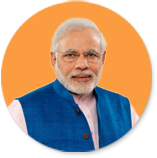suggestion Renewed Focus on Building World Class Infrastructure for New India
We are moving towards building New India infrastructure that meets the global standards and becomes the backbone of national growth. Reiterating the centrality of infrastructural development in achieving the goal of becoming a $5 trillion economy, PM Modi in the election manifesto of 2019 had promised investment of around Rs. 100 lakh crore on modern infrastructure in the coming years. What PM Modi said is in line with his government’s work in investing massively in truly world-class infrastructure.
Since 2014, the Modi government’s constant push towards building an exceptional infrastructure in the country has been universally appreciated, be it railway, roads, air or water ways. India started building rural roads at double the pace as earlier, became the fastest highway builder in the world and also added 35 operational airports in just five years since 2014. Moreover, India also saw its first multi-modal terminal on the Ganga river and received the country’s first container cargo transported on inland waterways. The pace of commissioning broad-gauge tracks and completion of electrification has accelerated over the past 5 years.
The pace of transformation has only increased since then.
Railway infrastructure needs an investment of Rs. 50 lakh crore by 2030 and PPP approach will be used to ensure faster development and delivery of passenger freight services. If we talk about modern railway infrastructure two brand new trains - Vande Bharat Express and Tejas - were flagged off recently. Tejas is India’s first corporate train which is going to run between New Delhi and Lucknow. Delhi-Katra Vande Bharat Express which was flagged off recently will be a big gift for Jammu and Kashmir's development apart from promoting religious tourism.
India's civil aviation industry has been witnessing rapid growth in the past few years to become the seventh largest aviation market with 340 million passengers being handled at our airports in financial year 2018-19. It is expected to become the third largest by 2024 surpassing countries such as the UK, Japan, Spain, and Germany. The Modi Government’s focus on connectivity for all has been one of the key drivers propelling its growth and placing the civil aviation industry amongst the fastest growing industries in the country.
The Government has decided to sanction 12 more routes under UDAN Scheme taking the total number of operational routes to 186. This will further stimulate regional air connectivity and make air travel affordable to the masses. Union Budget of 2019 has also proposed to adopt suitable policies to make India a global hub for maintenance, repair and overhaul (MRO) industry to achieve self-reliance in the aviation sector and create aspirational jobs in aviation finance.
Under the Make In India initiative, Mumbai has now got its first metro coach manufactured by Bharat Earth Movers Limited (BEML). The indigenous metro coach was built by BEML at its Bengaluru facility in 75 days. As per the current progress, the length of metro network of the Mumbai city, from the current 11 km will increase to 325 km by 2023-24.

At the foundation laying stone of new metro lines in Mumbai on September 9, 2019
Roads and highways, which are the arteries of India, need to be expanded and upgraded on a massive scale to achieve a $5 trillion economy. Out of Rs. 100 lakh crore to be invested on infrastructure, Rs. 15 lakh crore will be invested on building roads alone.
Bharat Mala Pariyojana which was launched by Modi government in its first term, focuses on optimized movement of freight and passenger traffic across the highways. Bharatmala Pariyojana is developing and upgrading 34,800 km of National Highways with an outlay of Rs. 5.35 lakh crore from 2017-18 to 2021-22.
Also, apart from building roads, tunnels and bridges are being developed too. Development of India’s longest ever tunnel, Chenani-Nashri, as well as India’s longest bridge, Dhola-Sadiya, and India’s longest railroad bridge Bogibeel, happened in the first tenure of Modi government.
To boost infrastructure further, FDI policies have been relaxed. Many FDI provisions were reformed so that the world invests in India. Also, these changes will make India an attractive FDI destination, leading to increased investments, employment and growth.
Some of the provisions are
- 100 percent FDI under automatic route for coal mining will attract international players and make the coal market more competitive.
- Contract manufacturing equally contributes to the objective of Make in India. FDI under automatic route is permitted in contract manufacturing.
A number of steps are being taken to develop infrastructure that raises quality of life. During 2019-20 to 2021-22, 1.95 crore houses are proposed to be provided to eligible beneficiaries under the Pradhan Mantri Awas Yojana – Gramin. By 2022, the 75th year of India’s independence, the Modi government will also ensure that every single rural family has an electricity and a clean cooking gas connection.
Fulfilling a promise made in the manifesto and in the election campaign, to urgently but comprehensively address water-related issues, a Jal Shakti Ministry was formed as promised.
This push will further accelerate the process of India becoming a 5 trillion dollar economy by 2024.



 Comment 0
Comment 0 

